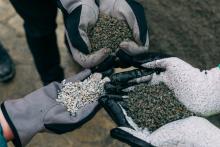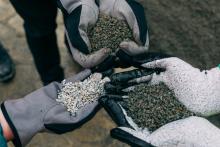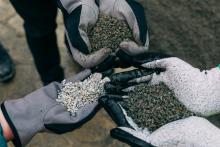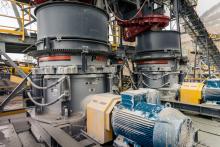The global aggregates market is expected to be worth US$608.9bn by 2026, according to a new study by U.S.-based Big Market Research, a business market intelligence consultancy. The rise equates to a CAGR (Compound Annual Growth Rate) of 4.6% from 2019 to 2026. According to Big Market Research’s (BMR) ‘Aggregates Market Development by 2026’ report, the global aggregates market was worth $429.1bn in 2018.
[caption id="attachment_108474" align="aligncenter" width="300"] The global aggregates market is expected to be worth US$608.9bn by 2026, according to Big Market Research. Pictured are crushed and screened granite aggregates – pic: Metso[/caption]
The global aggregates market is expected to be worth US$608.9bn by 2026, according to Big Market Research. Pictured are crushed and screened granite aggregates – pic: Metso[/caption]
The BMR study highlights how aggregates are the most mined products globally. They are available in a wide variety of types and sizes including amber flint, red granite, black basalt, corn flint, pearly quartz, green granite, blue gritstone, CKC, copper slag, Dobbs weir, and silver slag. Aggregates are used in manufacturing concrete and building railway ballast and roads. Also, widely used construction aggregates include stones, crushed stone, and gravel.
Globally, BMR notes that the aggregates market is largely driven by use of aggregates in construction of bridges, ports, highways, and roads. The new report adds: “The market is expected to grow rapidly over the estimated timeframe due to the expansion of the construction industry in various developing economies, such as China, India, and Brazil. The government of China is focused to boost its infrastructure and construction spending in a bid to fuel its economic growth. This factor is anticipated to positively impact the growth of the market.
“Furthermore, the ongoing trend of constructing smart cities in emerging nations are is also anticipated to fuel the growth of the aggregates market during the forecast period.”
The BMR report explains how materials such as EPS balls, crushed rubber, crushed glass, and high density polyethene are used as alternatives for aggregate in geo-stabilisation projects, road bedding, and sub-grading material for railroad tracks. Such factors are expected by BMR to hinder global aggregates market growth. The business market intelligence firm says that another major factor restraining market development is the fluctuation in prices of raw materials and requirement for large investment capital to establish aggregate production facilities.
Additionally, BMR says many construction firms are focused toward acquisition and mergers to expand their business and increase their production capacities to fulfil the demand from the commercial and infrastructure sector. For instance, in July 2019, Mississippi Lime Co., a subsidiary of HBM Holdings acquired Calera, Alabama. Through this acquisition, Mississippi Lime aims to expand its business in North America, which, in turn, is expected to help increase the growth of market.
The BMR report analyses four geographical regions: North America (U.S., Canada, and Mexico); Europe (Germany, France, the UK, Russia, and rest of Europe); Asia-Pacific (Japan, China, Australia, India, and rest of Asia-Pacific); and LAMEA (Latin America, the Middle East, and Africa). Asia-Pacific is expected to hold the largest market share throughout the study period, owing to the expansion of the construction industry and strong economic growth in China and India. The Chinese government has announced a three-year action plan (2018–2020) to build mega infrastructure facilities for development of modern China. Similarly, India’s government has started a number of projects for the development of railways and highway and roadway infrastructure. The projects are due be completed by 2020.
The LAMEA (Latin America, Middle East & Africa) region is expected to see the fastest aggregates demand growth rate due to large investments in construction of roadways. For instance, African and Middle Eastern countries have witnessed significant growth in the consumption of aggregates due to the boom in oil economy and rise in number of infrastructure development projects. Europe is also said by BMR to be witnessing growth in aggregate consumption due to the rapid recovery of Eastern Europe countries from financial and fiscal crises heralding a growth in commercial construction. The North American aggregates market is said to be growing, owing to the presence of competitors such as Martin Marietta Materials, Vulcan Materials Company, and LafargeHolcim.
In an executive summary of the BMR report, Vivek Banik, BMR senior research analyst, Construction and Manufacturing, says: “A wide range of domestic [aggregates] players are expanding their business in China and India to increase customer base, enhance effective operations, and product portfolios. This is anticipated to fuel the demand for aggregates in the Asia-Pacific region. Also, by application, the concrete segment is expected to experience a rapid surge due to the rise in the construction sector, especially in North America and Asia-Pacific.”
The key global aggregates market players profiled in the BMR study include Adelaide Brighton, CEMEX, CRH, Eurocement, Hanlon Concrete, Heidelberg Cement, LafargeHolcim Group, LSR Group PJSC., Martin Marietta Materials, and Vulcan Materials Company. Other companies operating in the market are Wharehine, Aggregate Industries, Okanagan Aggregates, Rock Road Companies, and Kuari Pati Sdn Bhd.
For enquiries about purchasing BMR’s full ‘Aggregates Market Development by 2026’ report, visit www.bigmarketresearch.com








